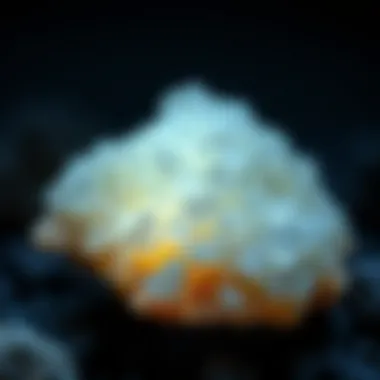Exploring Glow Minerals: Nature's Radiant Wonders


Intro
Glow minerals captivate our imagination with their ability to radiate light in the dark, embodying nature's artistry in geology. These eye-catching stones, glowing under ultraviolet light or in complete darkness, spark the interest of collectors, scholars, and casual enthusiasts alike. This article provides an in-depth look at the formation, types, and cultural significance of these remarkable minerals and serves as a comprehensive guide for those keen on exploring this luminous realm.
From the chemistry behind their glow to practical advice for identification, care, and collecting, each section sheds light on the myriad aspects of glow minerals. With a mixture of scientific rigor and accessible language, we aim to intrigue both the amateur and the seasoned collector.
Our journey dives into the fascinating world of these minerals, showcasing why they have earned a permanent place in the hearts of geology enthusiasts.
Featured Collectible of the Month
Overview
One of the standout specimens worth spotlighting this month is the beautifully luminescent Willemite from the Franklin Mining District in New Jersey. This mineral, often seen in vibrant greens, emits a striking glow when exposed to ultraviolet light, showcasing the beauty that lies beneath its rough exterior.
Willemite's presence in the collector’s realm is significant; its distinct luminescence not only captivates but also serves educational purposes in mineralogy. For rock hounds and casual collectors alike, Willemite stands as a remarkable reminder of the awe-inspiring formations that emerge from natural processes.
Historical Significance
The historical significance of Willemite dates back to the 19th century when it was first discovered in New Jersey's Franklin and Sterling Hill mines. The region is celebrated as one of the most remarkable mineralogical sites in the world. Willemite was named after the Dutch King William I, reinforcing its historical roots. Its discovery shifted the perceptions around fluorescing minerals and contributed massively to the growth of mineralogy as a scientific discipline. Many collectors seek out Willemite not just for its radiant glow, but for its rich heritage and contribution to our geological understanding.
Identification Techniques
Visual Characteristics
When it comes to identifying glow minerals, visual characteristics play a crucial role. Look for the following:
- Color: Many glow minerals exhibit vibrant colors under UV light which can differ significantly from their appearance in natural light. For example, Willemite may appear grayish or dull when viewed normally but bursts into a lively green or yellow under UV light.
- Texture: Many glow minerals have unique textures that can include smooth, crystalline surfaces or rough, jagged edges which affect how they interact with light.
- Infrared and Ultraviolet Response: Familiarize yourself with notable glowing properties. Some minerals like fluorite may glow differently depending on the wavelength of light they are exposed to.
Resources for Identification
For those seeking to deepen their understanding and practice their skills in identifying glow minerals, consider looking into the following resources:
- Mineralogical Society of America - A trusted platform for educational materials and resources.
- The British Geological Survey - Offers numerous articles and databases that detail mineral compositions and properties.
- Mineral Collectors on Reddit - A community where enthusiasts share information, advice, and images to aid in identification and collecting.
In this captivating journey through the world of glow minerals, we seek to ignite your passion for collecting and understanding these natural wonders. Each mineral tells a story, and with the right techniques, you can uncover the secrets these glowing treasures have to offer.
Preamble to Glow Minerals
The world of glow minerals presents a unique intersection of science and nature, captivating both casual observers and seasoned collectors. Understanding glow minerals is not just about admiring their aesthetic charm; it’s about grasping their geological significance and the intricate processes that lead to their luminescent properties. In this section, we will delve into the defining aspects that make these minerals special and why they are a worthwhile focus for rock and fossil enthusiasts.
Definition and Characteristics
Glow minerals refer to a set of minerals that possess the ability to emit light under certain conditions. This luminescence can be broadly categorized into fluorescence, where minerals emit light almost instantly when exposed to ultraviolet light, and phosphorescence, where the light continues to glow for a period even after the external light source is removed.
Some prominent characteristics of glow minerals include their vibrant colors and the intensity of their glow, which can vary greatly depending on the specific mineral and its environment. When examined under UV light, certain minerals will light up like a Christmas tree, displaying shades of green, orange, or blue that can leave observers in awe. For example, the mineral calcite often shows strong fluorescence with a bright blue hue, while willemite gives off a vibrant green glow, creating a stunning visual display.
From a more chemical perspective, glow minerals may contain specific elements or impurities that contribute to their luminescence. For instance, the presence of manganese or rare earth metals can enhance the glowing effect. This aspect of glow minerals highlights their diversity and the geological stories they tell.
Scientific Background
The scientific study of glow minerals intertwines disciplines like geology, chemistry, and physics. Understanding how these minerals emit light involves examining the mechanisms of luminescence which revolve around electron transitions within their atomic structure. When exposed to radiation, electrons can absorb energy and jump to a higher energy state. Once they return to their original state, they release energy in the form of light. This process is what creates the captivating glow.
Notably, not all minerals exhibit luminescence; it requires specific conditions – including geological processes, temperature, and the presence of certain impurities – to develop these unique characteristics. The environment in which the mineral formed plays a critical role. Minerals formed through processes like hydrothermal alteration or volcanic activity are more likely to exhibit glowing properties.
In summary, glow minerals present an intriguing topic for exploration due to their distinct properties and the scientific principles behind their luminescence. Collectors and enthusiasts can enjoy the beauty of these wonders while also gaining an understanding of the geological processes that shaped them.
"Through understanding the nature of glow minerals, enthusiasts not only deepen their appreciation for geology but also enhance their ability to identify and collect these radiant specimens.”
For further exploration into the intricate world of glow minerals, one can refer to resources such as Wikipedia or scholarly articles found in Britannica that delve deeper into the scientific principles at play.
Types of Glow Minerals
Understanding the types of glow minerals is paramount in appreciating their unique beauty and functional applications. These minerals, imbued with the ability to emit light, can be broadly categorized into three types: fluorescent, phosphorescent, and those exhibiting Cherenkov radiation. Each category is defined by its distinct mechanisms of luminescence, which not only influence their physical appearance but also dictate their practical uses across various fields, from art to industrial applications. With this knowledge, rock and fossil collectors can enhance their collections and gain deeper insights into the geological processes that shape our world.
Fluorescent Minerals
Fluorescent minerals are perhaps the most recognized category among glow minerals. These are the stones that light up dramatically under ultraviolet light, providing a visual feast that is insatiable for collectors. When exposed to specific wavelengths of UV light, fluorescent minerals absorb energy and then re-emit it, typically in a shorter wavelength, creating a spectacular glow.
A common example is fluorite, known for its vibrant hues that can range from blue to purple, turning into a brilliant green under UV light. Some other notable fluorescent minerals include calcite, willemite, and autunite. This ability to fluoresce is often linked to the presence of trace elements, such as manganese or rare earth metals, which serve as activators in the chemical processes at play.


Collectors find fluorescent minerals fascinating not just for their glow, but also for their ability to tell stories of geological formation and element presence. Knowing how to identify these minerals can enhance any hobbyist's collection; just remember to take along a UV light when on your mineral-hunting expeditions.
Phosphorescent Minerals
Unlike their fluorescent counterparts, phosphorescent minerals store energy absorbed from light over a period of time and then release it slowly. This effect can lead to a lasting glow even after the initial light source has been removed. The classic example of this phenomenon is strontium aluminate, which is known to glow in the dark for hours after exposure to light.
Other phosphorescent minerals, such as zinc sulfide, can provide curious enthusiasts with an enchanting sight, especially in low-light conditions. These materials often find their applications in glow-in-the-dark products, from toys to emergency signs, indicating their practical relevance beyond aesthetic appeal.
A necessary consideration for collectors is that not all minerals with phosphorescent properties glow for extended periods. The length and intensity of the glow are influenced by environmental factors and mineral composition. Thus, understanding the specific conditions of each specimen is crucial for accurate display and appreciation.
Cherenkov Radiation Minerals
Cherenkov radiation presents a more complex but equally fascinating category of glow minerals. This phenomenon occurs when charged particles, such as electrons, travel faster than the speed of light in a particular medium—typically water or some crystalline structures. When this happens, a characteristic blue glow is emitted, which is often associated with nuclear reactions or certain cosmic events.
This type of luminescence isn't just limited to scientific laboratories; some minerals, like zircon, exhibit this radiation under particular conditions. The properties of these minerals are not only of great interest to collectors but also to physicists exploring advanced applications in radiation detection and imaging.
A consideration for collectors here is that Cherenkov radiation can require specific containment, making general collection tricky; enthusiasts should focus on understanding the scientific principles behind these rarer specimens and their unique contexts in geological exploration.
Cherenkov radiation illustrates how glow minerals can unveil secrets about both astrophysical phenomena and fundamental physics, enriching our understanding of the universe.
In summary, the types of glow minerals—fl fluorescent, phosphorescent, and those exhibiting Cherenkov radiation—each offer unique insights and dazzling displays, making them intriguing subjects for study and collection alike. An appreciation for the diverse mechanisms that give these minerals their light is essential for any committed collector looking to deepen their hobby.
Formation Processes of Glow Minerals
Understanding how glow minerals form is like peeling back the layers of an onion. These natural wonders don’t just appear magically; there’s a whole process that takes place over time under specific conditions. Exploring these processes sheds light on not only the minerals themselves but also the environments that foster their creation. This section focuses on geological conditions and the roles that impurities and elements play in the formation of these luminescent gems.
Geological Conditions Required
The formation of glow minerals is predominantly influenced by geological conditions – think of it as the stage on which these minerals perform. Each mineral type has its own set of criteria, creating a backdrop that makes them thrive. Here are some key conditions that must be met:
- Temperature: High temperatures can lead to the formation of certain luminescent minerals. For example, minerals like strontium aluminate often form in volcanic environments where heat is abundant.
- Pressure: The pressure within Earth's crust affects mineral stability and formation. Higher pressures can result in unique crystallization patterns that enhance luminescence when viewed under ultraviolet light.
- Hydrothermal Processes: Many glow minerals are formed through hydrothermal activities. When hot water rich in minerals escapes from magma, it can deposit minerals like fluorite, which then exhibit fluorescence.
- Sedimentary Conditions: Some minerals also form in sedimentary environments where fine particles settle. Over time, these particles can compact and lithify into luminescent minerals, such as calcite, which may fluoresce when exposed to certain wavelengths of light.
These geological conditions ensure that glow minerals are not just a coincidence of nature, but the result of complex processes requiring specific environments.
Role of Impurities and Elements
Now let’s get into the nitty-gritty—the role of impurities in the formation of glow minerals cannot be overstated. When discussing minerals, one often thinks of their composition as a straightforward listing of elements, yet it’s the impurities often present that can turn an otherwise ordinary mineral into a show-stopper under the right light.
- Trace Elements: Some glow minerals derive their luminescent properties from trace elements like manganese, zinc, or rare earth elements. For instance, the presence of small amounts of manganese in calcium fluoride can significantly enhance its fluorescence.
- Chemical Interactions: The interplay between various elements can also lead to interesting results. Sometimes, an element like copper can replace another in a mineral's structure, causing a shift in how it absorbs and emits light.
- Color Centers: In several minerals, defects in their crystalline structures can create what are called "color centers." These defects can be caused by impurities or structural anomalies, and they can capture energy from light and re-emit it in vibrant colors.
Overall, it’s the unique combination of geological conditions and the specific presence of impurities that set the stage for glow minerals to shine brightly in their own right. Engaging with these processes not only amplifies our appreciation of these minerals but also informs collectors about what to look for in authentic specimens.
The Science of Luminescence
Understanding the science of luminescence is fundamental to appreciating glow minerals. This natural phenomenon covers various processes through which materials emit light without being heated. It signifies the interaction between electromagnetic radiation and matter, which can lead to the captivating visuals we see in certain geological specimens. The significance of luminescence in minerals is twofold: it aids in mineral identification and plays a critical role in various industrial applications.
Mechanisms Behind Light Emission
Luminescence can be produced through several mechanisms, each based on distinct electronic processes. The two primary mechanisms responsible for light emission in glow minerals are fluorescence and phosphorescence.
- Fluorescence occurs when a mineral absorbs energy, typically from ultraviolet light, and quickly re-emits it as visible light. This happens in a matter of nanoseconds, meaning the glow ceases almost instantaneously once the stimulating light is removed. A common example of a fluorescent mineral is the mineral calcite, which shows bright hues under UV light.
- Phosphorescence, on the other hand, is a delayed form of luminescence. Here, minerals not only absorb energy but can also hold onto that energy for much longer, sometimes even minutes to hours. The mineral strontium aluminate is a prime example as it glows for an extended period after being exposed to a light source.
The differences in these mechanisms influence both the appearance and the potential applications of each mineral. Knowledge of these processes allows collectors to appreciate the unique characteristics that each glow mineral exhibits.
Impact of Ultraviolet Light
Ultraviolet light acts as the primary source for many glow minerals to display their luminescent properties. When UV light strikes a mineral, it energizes electrons, raising them to higher energy states. Upon returning to their original state, these electrons release energy in the form of light.
The intensity and color of the emitted light can vary remarkably based on what elements are present in the mineral's structure. For instance, minerals with iron might produce a greenish glow, while those containing calcium may emit a bright orange.
Moreover, the interaction with UV light can vary depending on the mineral's atomic structure, creating a diverse tapestry of luminescent effects across various specimens.
"The glow of a mineral under UV light is not just pretty; it’s a window into its atomic world."
Applications of Glow Minerals
The applications of glow minerals span across multiple fields, showcasing their coveted properties and usefulness. From industrial applications that keep the wheels of progress turning to artistic endeavors that breathe life into creative projects, these minerals serve as a testament to nature's ingenuity. The vibrant luminescence and unique characteristics of glow minerals have inspired scientists, artists, and industry leaders alike. As we explore these applications a bit deeper, we can see the way they blend functionality with artistry, making them a fascinating subject for hobbyists and scholars alike.
Industrial Uses
Glow minerals have found a varied array of applications in industries that rely on their luminescent properties. Here are some key areas where these minerals really shine:


- Lighting Solutions: Certain glow minerals are incorporated into luminescent powders, which are used in emergency lighting solutions. When the lights go out, these materials can provide a guiding glow, ensuring safety in critical situations. A product that exemplifies this is the phosphorescent pigment that can be used in paint. This pigment glows after being charged by light, offering both safety and aesthetic appeal.
- Medical Devices: Beyond their visual appeal, some glow minerals serve essential roles in the medical industry. Mineral components are often found in imaging techniques, particularly in X-ray systems. They help improve the clarity and precision of the images produced, leading to better diagnostic outcomes. This intersection of geology and medicine illustrates the practical significance of glow minerals.
- Consumer Electronics: The electronics sector employs glow minerals in the manufacturing of displays and screens. Fluorescent materials, such as those derived from minerals like willemite, enhance the brightness and color vibrancy of screens. This application highlights how the beauty of glow minerals contributes to the tech we use daily.
- Construction Materials: Some companies are also venturing into glow-in-the-dark concrete. By integrating fluorescent materials into concrete mixtures, they produce pathways or walkways that glow at night, enhancing visibility and aesthetics in public spaces.
Decorative and Artistic Uses
Glow minerals have also found a treasured place in the world of art and decoration. Artists and designers utilize these materials to bring a playful yet profoundly expressive element to their work. Here are some noteworthy usages:
- Art Installations: Many contemporary artists have begun to explore the captivating allure of glow minerals in their installations. By integrating fluorescent stones into their works, they create dynamic environments that shift in appearance depending on the lighting conditions. Such creations have a mesmerizing effect, captivating viewers and encouraging them to engage more deeply with the artwork.
- Jewelry Making: Designers often use glow minerals in crafting unique pieces of jewelry. The allure of a necklace that glows subtly in the dark or a ring that captures the light and shines brightly is appealing to many. There lies a unique charm in using natural elements that not only look good but also carry the story of their origin.
- Interior Design: Interior decorators are increasingly turning to luminescent elements. From wall art featuring glow-in-the-dark pigments to personalized home décor items made with glow minerals, the applicability of these radiant wonders in creating inviting and organic ambiance is ever-growing. Mixing traditional styles with a modern twist not only breathes life into spaces but also helps create a welcoming atmosphere.
Collecting Glow Minerals
Collecting glow minerals opens a vibrant window into the natural world, merging passion with science. Such a hobby isn't just about gathering sparkly rocks; it’s an engaging pursuit that frosts the cake of geology with hands-on experience. The sheer variety available—from common fluorescent minerals to the rare phosphorescent gems—makes the act of collecting foundations for both enjoyment and education.
Identifying Authentic Samples
When diving into the fascinating field of glow mineral collection, one of the most crucial skills to develop is the ability to identify authentic samples. Fakes and imitations are regrettably common, and without a practiced eye, collectors might find themselves with a bunch of glimmering imposters instead of genuine specimens.
To begin with, it’s essential to familiarize oneself with the characteristic features of glow minerals. For example, true fluorescent rocks often exhibit specific colors under UV light that differ from their appearance in natural light. Conversely, phosphorescent minerals will continue to emit light after the UV source is removed, their glow gently fading rather than abruptly stopping.
Here are a few tips to identify authenticity:
- Examine Texture: Authentic minerals generally have a natural texture. If a rock feels too smooth or looks overly polished, it might be a manufactured piece.
- Check for Internal Flaws: Many genuine minerals have unique internal structures. Using a magnifying glass can help spot tiny air bubbles of other manufacturing indicators.
- Seek Professional Help: When in doubt, rely on expert opinions or labs that specialize in mineral identification.
Always remember, a knowledgeable collector doesn't just buy based on aesthetics; they dig deeper!
Storage and Care Practices
Once you’ve amassed a gorgeous collection of glow minerals, the next challenge is maintaining their beauty and integrity. Proper storage and care are pivotal because these specimens can be quite delicate and susceptible to damage over time.
Here are the essential practices you should consider for safeguarding your collection:
- Keep Away from Direct Sunlight: Many glow minerals are sensitive to light exposure. Store them in a dark environment, preferably in opaque containers or drawers.
- Temperature and Humidity Control: Extremes in temperature or humidity can negatively impact many minerals. A consistent environment, ideally cool and dry, helps in preventing degradation.
- Use Soft, Non-Abrasive Materials: When handling or showcasing your minerals, ensure you’re using soft cloths and non-abrasive holders or stands. This minimizes the risk of scratches or surface damage.
- Display Cases with UV Protection: If you want to showcase your collection, opt for display cases that include UV protection. This will shield your minerals from potential fade and preserve their glow.
Even with the best intentions, mishaps can occur. Regularly inspecting your collection for signs of wear or damage can help catch issues before they become serious.
"A well-preserved mineral is not just a specimen; it's a snapshot of Earth's history."
For a deeper understanding of mineral care, consider checking out government and educational resources such as *.edu or *.gov. Collecting glow minerals is a journey, and each step you take towards better care will elevate your experience.
Comparative Analysis of Glow Minerals
Comparing glow minerals serves more than just academic interest; it shines light on the intricacies of luminescence. By understanding how different types of glow minerals behave under various conditions, enthusiasts and scholars can enhance their appreciation of these captivating natural wonders. The comparative analysis also provides insight into how these minerals interact with their environment, leading to a better understanding of their formation, properties, and potential uses.
Differences Between Fluorescent and Phosphorescent
Fluorescent and phosphorescent minerals are both types of luminescent materials, yet they differ significantly in their light-emitting processes. Fluorescence occurs when a mineral absorbs light, typically ultraviolet, and then almost immediately re-emits it. The process is quick, often lasting only a few microseconds to milliseconds after the excitation source is removed. Common examples of fluorescent minerals include calcite and fluorite, known for their vibrant glow under UV light.
In contrast, phosphorescent minerals can hold onto their glow for a much longer time after the excitation source is turned off. They absorb energy and then slowly release it, which can last from seconds to hours, sometimes even longer. A well-known example is strontium aluminate, which has captivated collectors for its glowing properties that can persist long after the lights go out.
The significant difference between these two types can be summed up as follows:
- Fluorescent: Quick emission, immediate cessation.
- Phosphorescent: Prolonged emission, enduring afterglow.
This distinction is crucial for collectors who are interested in acquiring minerals not just for their aesthetic appeal but also for their unique properties.
Intersections with Other Geological Phenomena
The interactions between glow minerals and other geological phenomena can create a fascinating tapestry of natural beauty and science. For instance, volcanic activity can influence the formation of certain glow minerals. Elements released during volcanic eruptions can lead to unique formation conditions that result in luminescent properties. Additionally, the presence of radioactive materials in geological settings often correlates with luminescent phenomena, leading to the formation of glow minerals that exhibit unique radiation characteristics.
There are also instances where glow minerals can be found in sedimentary environments. The interplay between sedimentation processes and mineral formation can yield incredible examples of phosphorescence and fluorescence as various elements become trapped within the matrix, often as a result of heating, pressure, or chemical interaction.
Understanding these intersections is vital for collectors, as it unveils the broader context in which these minerals exist, highlighting their allure not just as objects of beauty, but as specimens that tell the stories of the Earth’s dynamic processes.
“Glow minerals are not only striking in appearance; they offer a glimpse into the Earth’s fiery history and dynamic nature.”
To delve deeper into the subject, consider resources such as Wikipedia or academic journals accessible through Google Scholar.
Cultural Significance of Glow Minerals
The allure of glow minerals stretches beyond their dazzling luminescence; their cultural significance weaves through history, myth, and contemporary art. These radiant stones have captivated imaginations for centuries, serving as symbols, tools, and cherished objects across a plethora of societies. Understanding this cultural context enriches the appreciation of glow minerals, providing insight into how humans have intertwined their narratives with these geological marvels.


Historical Context and Applications
Glow minerals have played various roles through time. From ancient civilizations to modern societies, they have been regarded as carriers of meaning and power. In many cultures, glow minerals were believed to possess mystical properties. For instance, certain tribes in South America used luminescent minerals in their spiritual ceremonies, believing these stones could illuminate paths to the divine or bring protection from malevolent spirits.
Moreover, the use of glow minerals is not confined to ritualistic practices. During the Middle Ages, these minerals found their way into the art of alchemy, where they were thought to hold the key to transmuting base metals into gold or achieving immortality. The persistent fascination speaks volumes about humanity’s quest for knowledge and understanding of the natural world.
- Practical Uses: In addition to their ceremonial roles, glow minerals were used for practical applications. Ancient artisans crafted tools and ornaments, utilizing the unique visual traits of these minerals. The iridescent quality of certain stones allowed for their incorporation into jewelry and decorative items, making them coveted assets in many cultures.
Influence on Modern Art and Design
In today's world, glow minerals continue to inspire creativity across various artistic fields. Artists, designers, and architects are drawn to their vibrant hues and transformative properties. Contemporary art installations often incorporate luminescent minerals to create immersive experiences that challenge perceptions of light and space. Their diverse palettes add depth and intrigue, quite literally illuminating the creative process.
For example, pieces featuring glow minerals may serve as focal points in environmental art, allowing nature and human creativity to coexist harmoniously. These installations not only showcase the beauty of the materials but also raise awareness about the ecological significance of glow minerals, encouraging sustainable practices in their collection and display.
- Fashion Industry: Similarly, the fashion industry has also found innovative uses for glow minerals. Designers, aiming to make statements or push boundaries, integrate these elements into clothing and accessories. This trend reflects a broader cultural shift, where nature's intricacies are seen as a vital part of human expression.
In summary, the cultural significance of glow minerals transcends their physical beauty, embedding them in the fabric of human history and creativity. From ancient rituals to modern artistic expressions, their luminescent properties continue to bridge the gap between the earthly and the ethereal.
Challenges in the Study of Glow Minerals
The exploration of glow minerals is a riveting yet complex endeavor. Delving into this topic brings to light numerous challenges that researchers and enthusiasts face. While the allure of their luminescence captures the imagination, the journey to fully understand these minerals hinges on various intricate elements that can make or break a study. From inherent research limitations to pressing environmental considerations, each facet plays a crucial role in shaping our comprehension of these geological marvels.
Research Limitations
One of the starkest hurdles experienced in the scientific study of glow minerals is the limited availability of comprehensive research resources. Many glow minerals are scarce or found in isolated locations, leading to insufficient data. For instance, the availability of specimens such as benitoite, a rare fluorescent mineral found in California, is a case in point. Because these minerals are often only located in specific regions, opportunities for extensive sampling and detailed comparative analyses become constrained.
Additionally, the technological tools available for luminescence studies can be quite specialized and costly. Advanced equipment for conducting spectroscopic analysis, such as lasers and high-resolution detectors, might not be accessible to all researchers or enthusiasts. This can hinder their ability to perform rigorous tests and obtain accurate readings. A lack of adequate funding for research projects further exacerbates these issues. Research teams might find securing grants for niche studies particularly challenging, thereby limiting the scope of exploration and discovery in this fascinating field.
- Limited data correlation: Often, findings from one region do not align with those from others, making it difficult to form universal conclusions about luminescent minerals.
- Rare sample availability: Many precious glow minerals only exist in limited quantities, making comprehensive studies impractical.
"Researching glow minerals is not just an academic pursuit; it’s an expedition into the unknown, faced with obstacles at every turn."
Environmental Considerations
The environmental aspects tied to the collection and study of glow minerals cannot be sidelined. With the growing awareness of ecological issues, researchers must tread carefully to ensure their activities do not lead to detrimental impacts on ecosystems. The extraction of minerals, particularly in vulnerable habitats, poses risks. Over-collecting can lead to irreversible damage, not just to the mineral population but also to the surrounding flora and fauna.
Moreover, many glow minerals are often located in delicate geological formations, which are already at risk from climate change and human development. The balance between acquiring samples for research and preserving these natural sites becomes a fine line that must be respected. For example, in regions where luminescent minerals are found, new policies might be put in place to regulate mining activities, but this could hinder access for researchers who aim to study these magnificent natural wonders.
To navigate these challenges, it’s essential to establish responsible guidelines and sustainable practices in collecting glow minerals. Collaboration among geologists, conservationists, and government bodies could pave the way for responsible mining practices that respect the delicate balance of nature while allowing for scientific exploration.
In summary, the path to understanding glow minerals is fraught with challenges, from research limitations to environmental considerations. However, by addressing these hurdles, we can deepen our insight into the fascinating world of glow minerals, ensuring that these studies benefit both science and nature.
Future Directions in Glow Mineral Research
As the scientific community continues to delve into the intricate world of glow minerals, future research holds vast potential for breakthrough discoveries and advancements. This section will explore how emerging technologies and innovative thinking might reshape our understanding of these radiant geological wonders. The implications of this research stretch beyond geology, marrying disciplines such as environmental science, materials engineering, and even art.
Emerging Technologies
The advent of sophisticated imaging technologies, such as hyperspectral imaging and advanced electron microscopy, are setting the stage for a transformative era in glow mineral research. These tools allow researchers to accurately map the composition and luminescent properties of minerals at microscopic levels, delivering a wealth of data that was once out of reach. This increase in precision could lead to better identification techniques for minerals, allowing collectors to determine authenticity with confidence.
Moreover, innovations in laser technology are providing new methods to excite luminescent properties in glow minerals. Researchers are able to manipulate light frequencies, creating targeted excitation that could enhance understanding of the emission mechanisms at play. As a result, the study of glow minerals could intersect with fields like photonics, paving the way for novel applications in lighting and display technologies.
Potential for New Discoveries
The potential for new discoveries in the realm of glow minerals is limited only by the boundaries of human imagination and scientific inquiry. As we harness advanced computational models and machine learning algorithms, predictive analytics can identify locations that are likely to yield undiscovered glow minerals. This data-driven approach combines geological surveys with machine learning to unearth not just new specimens but entire classes of mineral findings that were previously overlooked.
Collectively, future investigations might reveal unexpected relationships between glow minerals and environmental factors. For instance, examining how various global changes, such as climate shifts or land use, impact the luminescent properties of minerals can provide valuable insights into the Earth's geological history. It’s a win-win: expanding knowledge while potentially aiding conservation efforts that seek to protect these precious geological treasures.
"As the world of science becomes more interconnected with technology, the potential to unravel the mysteries within glow minerals continues to grow, propelling us into an era of discovery beyond our current horizon."
In summary, the future directions in glow mineral research present a kaleidoscope of possibilities. With emerging technologies on the cusp of revolutionizing identifications, and the untapped potential for new discoveries ready for exploration, the allure of glow minerals remains as vibrant as the luminescent properties that make them so fascinating.
For those interested in the innovative intersection of technology and geology, keeping an ear to the ground about advancements can be beneficial. Engaging with communities on platforms like Reddit or following articles on sites such as Britannica can provide additional insight into ongoing discussions and research.
Culmination
Concluding this deep dive into glow minerals emphasizes their multifaceted nature and the profound significance they hold not only in geology but also in culture and industry. These radiant wonders demonstrate unique properties that allow them to captivate both scientists and collectors alike.
Recap of Key Insights
Throughout the exploration, we’ve uncovered various types of glow minerals, ranging from fluorescent to phosphorescent. Each type comes with its own set of characteristics and formation processes that stem from intricate geological conditions and impurities within the earth. Additionally, we touched on the remarkable science behind luminescence, elucidating how minerals emit light when exposed to certain stimuli like ultraviolet rays. The applications of these minerals are vast, extending from industrial roles to artistic inspirations, showcasing their versatility. Collecting and storing these gems involves a dedicated approach, where authenticity and care play pivotal roles in preserving their alluring qualities.
Encouragement for Continued Exploration
As we conclude, I encourage rock and fossil collectors to delve further into the world of glow minerals. There’s a treasure trove of knowledge yet to be uncovered. Whether you are examining rare specimens or experimenting with ways to display them, every aspect of glow minerals reveals more mysteries and beauty. Join local geology clubs, attend mineral shows, or explore academic resources to enhance your understanding. Share your experiences with fellow enthusiasts on platforms like reddit, where you can find a community eager to learn and exchange insights.
Every stone has a story, and by venturing into the realm of glow minerals, you become part of a broader narrative that connects us with the mysteries of our planet. Let curiosity guide you, and you might just stumble upon discoveries that shimmer not just in the dark but also in the life they bring to the study of geology.



